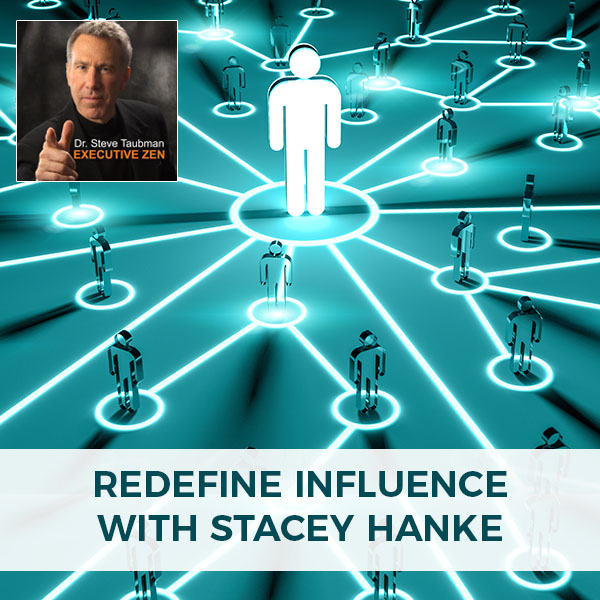
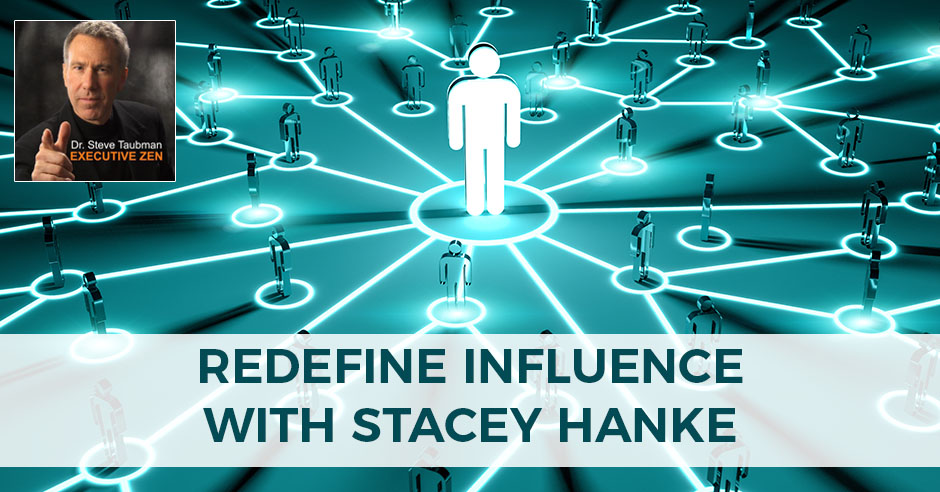
I’m excited to introduce Stacey Hanke, author of Influence Redefined…Be the Leader You Were Meant to Be, Monday to Monday® and co-author of Yes You Can! Everything You Need From A To Z To Influence Others To Take Action. She has trained and presented to thousands to rid business leaders of bad body language habits and to choose words wisely in the virtually every industry with clients like Coca-Cola, McDonald’s, and the US Army. In this fascinating discussion, Stacey and I explore the intersection of communication and awareness. A powerful topic with lots of great takeaways! Expect to come away with practical value for your business and personal life!
—
Listen to the podcast here:
Redefine Influence with Stacey Hanke
This episode’s topic is Redefining Influence. Our guest, Stacey Hanke, literally wrote the book. In business and personal life, influence is vital. You need to be able to influence the thoughts and behaviors of others or you’re out of business. Everything you do from galvanizing support from your team to recruiting new employees to selling your wares all involve influence. It’s the ability to sway the thoughts and actions of another to your point of view, hopefully, in an ethical way.
There’s a continuum of people out there. On one end of the spectrum there are those who think that influence is a dirty word and that we have no right to exert any influence on anybody else. Those people are either unaware of how often they use influence or they’re failing at life. You simply can’t be a parent, a teacher, an entrepreneur, anything that involves leadership, without having a healthy respect for your ability to influence and be responsible to do it in an ethical way. On the other end of the spectrum are those who have no qualms about coercing others into a set of actions, whether by force or trickery.
Madison Avenue has been traditionally in the market for trying to manipulate the perceptions of the American consumer to convince them to need things that they don’t need. I hate to tell you this, but all those lotions and potions, they’re not doing anything. Diamonds have no inherent value. Look it up. I would contend that ethical influence lies somewhere in the middle. We have to recognize that there are behaviors we’d like to assist people in changing, but that we’re not doggedly determined that we fail to take their dignity into account. We don’t treat others like hapless victims of our will.
In the previous shows, I’ve discussed conscious leadership and global citizenship with brilliant guests like Ryan Long of City Gala. What we concluded was that the new paradigm and flow in the world is that rather than using influence to create needs that don’t exist, we can look around us and we could see that the world already has plenty of grave need. We can identify those needs and we can then use influence to support the effort to meet those needs. In that case, influence might be empowering people to believe that change is possible. Maybe it’s helping people recognize the importance of teamwork or the value of respect. Maybe it’s offering people a chance to envision a new reality and that takes influence.
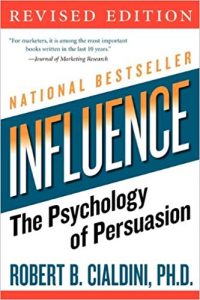
Influence: The Psychology of Persuasion
My first understanding of influence came from the pioneer in that area, Robert Cialdini. He’s a professor and author in the area of psychology and marketing and he wrote the book Influence. In it, he shares certain psychological principles that determine influence. One example is reciprocity. He says, “When we give others what they want, they are more likely to give us what we want.” If I give you something, you’ll probably feel more inclined to want to give me something like your time of the day. Maybe give me some of your advice if I’ve already been generous with mine. He says that reciprocity also applies to concessions. If I ask something of you and you say no, that means that I’ve essentially conceded to your response. That means that you owe me a concession. If I ask something else of you, you’re more likely to say yes. I’ll give you an example.
He shares this example of an experiment in which researchers were asked to invite passersby to take a kid to the zoo for the day. A very small number said yes. They were asked to invite people to become Big Brothers, that organization. Most of them said no, but then the researchers would say, “Would you at least be willing to take a kid to the zoo for the day?” A substantial number said yes. That’s reciprocity. That book’s filled with brilliant nuggets. I have adopted some of them in my work to create a great effect. I’m always monitoring myself to make sure I’m not being manipulative or inducing people to do things that aren’t in their best interest. The truth is that I grew up much more in that first camp I talked about.
Feeling not just that it was unethical to influence others, but that I didn’t deserve to be someone who did that. I was bullied as a child and I bore the scars of low self-esteem. Thinking I had the right to sway anyone was in direct opposition to my worldview. It took me some time to recognize the importance of owning my own power. Knowing that sometimes as a leader we need to see an outcome and own the responsibility to help make it real by exerting some influence. There are a lot of ethical and practical considerations in this work. In order to resolve them, I’ve brought an interesting guest. What struck me was that she resonated with my mindfulness approach, which we understand that the first person that we need to influence is ourselves.
How do we stop letting our old inner voices determine our realities? In my work, that’s about meditation and mindfulness practices. It’s becoming first the witness to your own inner voices, to your own inner dialogue, and then eventually becoming its influencer. Our guest is taking this much further. I’ll be speaking with a well-respected expert, author, and hopefully, she’ll be setting me straight about my wrap on influence. We’ll come away with ideas to improve your business and your capacity to influence.
—
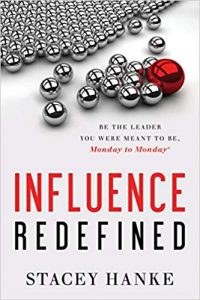
Influence Redefined: Be the Leader You Were Meant to Be, Monday to Monday
My guest is Stacey Hanke, author of the book Influence Redefined: Be The Leader You Were Meant To Be Monday To Monday. She also coauthored the book Yes You Can!: Everything You Need From A To Z To Influence Others To Take Action. She is the Founder of Stacey Hanke, Inc. She’s trained and presented thousands to rid business leaders of bad body language habits and to choose words wisely in the financial industry, healthcare industry, government, and everything in between. Her client list is vast from Coca-Cola, FedEx, Coles, United States Army, Navy and Air Force, McDonald’s, Publicis Media, Nationwide, US Cellular, Pfizer, GE.
Her team works with directors up this up to the C-Suite. In addition to her client list, she’s been the emcee for TEDx. She’s inspired thousands as a featured guest on media outlets including the New York Times, Forbes, Entrepreneur, Thrive, SmartMoney Magazine, The Economist, and Business Week. Stacey is a Certified Speaking Professional, that’s a rare attribute, a valued accreditation earned by less than 10% of speakers worldwide. Please welcome Stacey Hanke. Hi, Stacey.
Thanks so much for having the opportunity to hang out with you, Steve.
What a pleasure to have you here. My show and my reason for being are to introduce elements of mindfulness to the business community. It’s a gap in our education in the western world. As a result, people tend to run through life being not self-aware. I’m curious whether you think that mindfulness has a part in this conversation?
It’s a big piece of it and you’ll hear me talk about it depending on where this conversation goes. The way I define influence is through this whole idea of it being redefined, it takes a lot of work, thought, discipline, and most importantly, it takes focus. When your mind’s not in the right place, having influence is difficult. In our team when we work with executives one-on-one, the conversations start to lead towards mindfulness and meditation. As an executive, their lives are pretty intense. They’re a little bit more intense due to the pressure and the high stakes conversations that they have to have. A lot of our leaders are starting to move, at least starting to consider this idea of mindfulness, which is wild. The whole idea of meditation has been around for centuries and why it has taken so long, as Americans, to figure out the power of that in our personal and professional life.
That’s exciting what you’re saying about mindfulness becoming a component of the executive’s world. I’m seeing that beginning to dawn on people of influence and people in high-pressure situations. As we know, there’s no way to make wise choices and speak in an influential way if you’re not even aware of what you’re putting out there.
When people ask me, “How do you work with individuals to help them start to enhance, improve their influence?” I always say the first step is awareness because without that, a lot of us determine our level of influence. We determine how we come across to others, those that we interact with, and we base that on how we feel rather than what is fact. Once the self-awareness is there, then we can start working on the influence skills that I talk a lot about. That’s a lot about body language and your messaging. Without that self-awareness, you continue to go walking around life basing your level of effectiveness on how you feel.
The leader operates on objective reality rather than on feelings. Without the objective reality then they are unaware of the things that they might be doing that are having an influence unwittingly.
I am intrigued with how can we behave a certain way? How can we act a certain way? Deliver a message a certain way and say what we say, yet be clueless. There is such a disconnect between how we feel rather than how it comes across. That’s where I come in and say, “Here’s what we’re going to do to start increasing your self-awareness,” and I’m not saying that someone has to be perfect in their communication. The idea though is if you’re in a meeting and you’re doing something. Meaning your delivery or your message is not connecting, engaging with your listener. At least, you’re aware of it. You’re aware of it at the moment that you can change the message on the fly to make sure you adapt to them without ever skipping a beat.
There’s no way to make wise choices and speak in an influential way if you’re not aware of what you’re putting out there. Click To TweetI remember hearing Tony Robbins talking about the two components of successful communication being sensory acuity and behavioral flexibility. If you can’t see it happening, you can’t change it. If you can see it happening, at least you are behaviorally flexible of changing it.
This goes back to mindfulness, now that you brought up Tony Robbins. Think about you made a comment if you can see it. I’ve sat and observed leaders lead meetings. Half the room is down in their technical gadgets. Some individuals are having side conversations. The person facilitating the meeting continues to talk louder and faster, torturing their poor listeners even more because they’re not reading their listener. This is part of mindfulness. Part of our communication where we start to get caught up in is we get caught up in our own dialogue.
We start thinking that or believing if everyone showed up for this meeting or this virtual call, they will listen to me and that’s not the case. Just because they’re there doesn’t mean they’re going to listen. This is where you need to respect their time by working as hard as you can to be as mindful and focused as possible to make sure you can read when you’ve said too much. You’re going too long, you’re boring, or whatever it is to keep the listeners with you, with your entire message from start to finish. That’s tough to do, especially if you’re not mindful.
What do you suppose are the obstacles to that awareness or mindfulness? Do you think fear plays a part here? Are that people afraid to see the truth?
That’s part of it. The other part, I go back to lack of self-awareness, that they’re clueless. I don’t believe people understand how they truly come across. I noticed that for a fact because when my team and I do a lot of video recording to help increase people’s awareness. There were so many times where we hear people say, “I had no idea that’s how I came across,” or, “No wonder I always go over time,” or whatever their challenge is. The other thing is we get false feedback especially as we climb the corporate ladder. People start telling us what we want to hear. Usually, that feedback is, “Good. Nice job.” We walk around life saying everyone says we’re good. Without self-awareness, the little bit of the fear of not wanting to know the truth and never giving feedback, you can see how you continue to repeat the way you’ve always communicate it. Whether that’s good, adequate, or it works sometimes but not all the time. Some people are okay with that, which is totally fine. I’m here to give you that extra help on how to make sure that there are ways that you can continue to enhance how people experience you.
Influence means that you truly are communicating a message that your audience resonates with. Click To TweetDo you mind if we dig into your world and dig into what it looks from the stage or from the boardroom when you want to start inviting people to gain a higher level of self-awareness? I always have to, in a funny way, slap people in the face. How do you get people to recognize their blind spots?
I’m told by my clients I can be a little edgy, but they like it. I say to them, “You did not hire me to tell your people how good they are. That’s not why you want me here, it’s what’s not working for them.” One of the first things that I start to do, and it depends on the group size, was that we do a lot of videotaping. I know for a fact that if I tell a CEO they take too long to get to the point or they’re not connecting and engaging to the capability they have, that is going to fall on deaf ears most likely. You get someone up in front of a camera, which is the eyes and ears of your audience every day, that’s how you’re going to start to increase awareness. Without that, I have no idea. I wrote about this in the book. I had a CEO and I was videotaping him. We sit down to watch his first playback, maybe five seconds into the playback, he stops the recording, looks at me, and he says, “I bet you wonder how I ever became a CEO.”
It’s one of those awkward moments because you’re not sure, “Do I agree with that? Do I let that one go?” When I asked him where that comment was coming from, he admitted and said, “After watching the playback, I realized I am not receiving feedback.” My executive team is always talking about how great I am, and secondly, I have never watched myself on a playback. He was blown away by how he looked, how he came across, how he sounded when he watched the playback versus what he feels like. It’s typical for a leader to continue to advance in their career and sometimes it’s not always based on the level of influence. I had a company not too long ago, the VP of HR called and she said, “We’ve got a big conference coming up. It’s the only time the CEO presents to the entire company. We’d love for you to come and coach him and his executive team.” She goes, “I need to get back to you. We need to check on a couple of things before we bring you in.”

Influence Redefined: If I’m going to ask individuals feedback, I better make sure I’m doing the same.
A week goes by, she calls back and says, “We’ve decided to go in a different direction.” I’m all for the feedback. If I’m going to ask individuals to get feedback, I better make sure I’m doing the same. When I asked her the direction that they took, she said, “We’re not bringing anyone in. The coaching was more for the CEO, but when we told the CEO we wanted to bring you in, he said, ‘We don’t need it.’” They’re initially going behind his back to say, “Why don’t you come in?” and it’s for him, but then when they brought it up to him, that’s not happening. That’s not the case with everyone. We’re fortunate where a lot of executives that want mentoring, they’re reaching out for it. They’re coming to us because they get the power behind this idea of influence.
Let’s talk about influence and the end game. What does influence look like when somebody does have self-awareness? When they are capable of operating with logical feedback and they’re not rambling and they’re not doing all those things, what does it look like?
When your body language and your messaging are consistent Monday to Monday, that no one ever has to guess who shows up for the virtual call versus the hallway conversation or the high stakes presentation. The second part of how I think influence resonates is when you have this ability to move people to action long after the interaction has occurred. I’ll give you an example, and I am not claiming to be influential by any means. This is a lifelong process and I am a work in progress like everyone else is.
I know I’ve had an influence on someone when they may initially contact us and, at that time, it doesn’t work out for whatever reason. Three years, four years later, they come back and they say, “Now we can do this.” It might be now, “We’ve got the right leadership in play. We’ve got the right budget in play.” When someone has seen me at a conference and for whatever reason, it wasn’t right to bring me into their company. They reach out a year later and they say, “We saw you speak here. At that point, we weren’t quite ready, but we’ve kept your contact information. We’d like to bring you back in.”
To me that whole idea of, “I don’t want to have an influence on your audience for this short conversation.” I’d rather have an influence on the three months or a year from now. That to me takes a lot of focus, a lot of discipline, a lot of work, but it’s possible. It’s not impossible. Here’s where it’s different. After doing a lot of research and interviews, I realized that most people believe that influence is something, when you need it the most, you turn it on. I bet your audience can agree to this where perhaps they’re in a meeting and they know the person facilitating.
Influence is vital. You need to be able to influence the thoughts and behaviors of others or you’re out of business. Click To TweetThey know this person personally, yet every time they facilitate a meeting or when they’re in a high stakes conversation, they turn it on. You can tell that they become something that they’re not, or you can tell that they rehearsed their script. They don’t interact and they’re very much in their own agenda and checking off the box. That’s not influence because the next layer to influence means that you truly are communicating a message that your listeners can resonate with.
That you know that and you’re mindful. You’re looking them dead in the eye every time you speak. You’re aware of the energy, or the lack thereof, and everything that’s happening in that room. You’re not thinking about the emails coming in. You’re not thinking about what is traffic going to be when you have to go back home tonight or are you going to catch that flight back home tonight. You’re focused and you know you’re focused because after the meeting, there’s a level of exhaustion. You’re tired because you put in 150% of being in the moment physically and mentally.
It’s a different tired from the tired of overwhelm. It’s a much-earned rest tired. In that environment that you described, would you agree that that’s an environment in which you, the presenter who is being present is also inviting feedback? Whether it’s verbal or nonverbal feedback all the way throughout the whole process.
You got it and paying attention to it. How many times have you seen it where some individuals in the meeting are caught up in their emails? Clients will argue with me and say, “That’s part of our culture.” My response to that is, “Really? You’re going to fall into that?” If someone’s on their email while I’m in a conversation with them, their email is a lot more interesting than what’s standing in front of them. It’s the same thing when we’re on virtual calls. I’ve been on conference calls where whoever’s leading the meeting is a talking head. There’s no interaction, there’s no engagement, and you wonder, “Is anyone even paying attention to the other end?” We’re living in this world of noise. There are many messages we received 24/7, it makes it that much more difficult to stand out from the crowd. Standing out from the crowd means that you and your message is memorable. If it’s not, individuals will not act on your recommendation after that conversation has occurred. Now, you become part of the noise and part of the clutter.
What you’re suggesting requires courage. I believe there’s a certain amount of courage that’s necessary for someone to basically say, “Pay attention. Be with me and I’ll be with you. Let’s buck the tradition and not just be talking at each other.”
I talk a lot about focusing outward rather than inward. When we focus on inward, we think about, “Is everyone going like to me? Am I going to say the right thing? What if I mess up?” If you get stuck there in your head, that’s the type of mindfulness I’m not talking about, you will mess up. It’s going to be a cluster. If you can get the courage to think, “I truly have something to say. I have something to say that people will value from. I am here because I’ve prepared and I am not going to waste their time.”
Does a lot of that take practice? I think so. I truly believe in this whole idea of deliberate practice, just like an athlete practice. Here’s the good news, we have to put this level of focus, respect, and attention into all of our conversations. For example, when we’re out to dinner with friends and family and we pay attention to what’s happening at that conversation, that’s practice. The more you make this part of your day-to-day, the more it becomes your norm, especially when the stakes are high. That to me is where the courage grows.
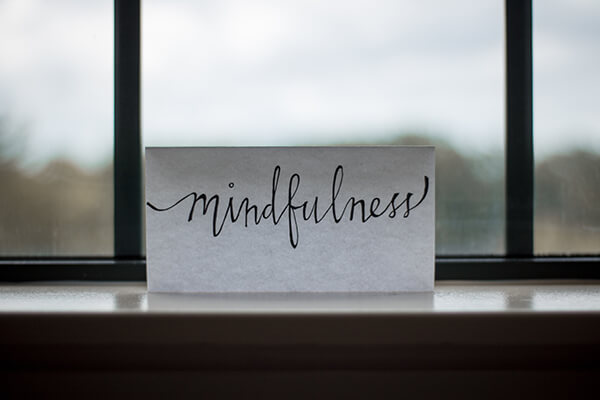
Influence Redefined: Any kind of mindfulness practice that puts you in the present moment is going to help you prepare more effectively.
Any mindfulness practice that puts you in the present moment is going to help prepare you more effectively. For those times, those business conversations, and people will notice it. They’ll notice that you’re listening more effectively, that you’re talking into their listening.
People can tell when you’re paying attention to them. I talk about eye connection rather than eye contact. Eye connection is anytime you’re speaking, you’re looking someone dead in the eyes. I’m not talking staring. That’s a whole other approach to connecting with people. A lot of us don’t look at people when we talk, we more scan them. For one-on-one with someone where we’re talking to their shoes or sometimes we’re talking to the top of their head or their shoulder, whatever it might be. That’s one way that people can tell you’re paying attention. The second is your word choice. Are you pausing to let, perhaps in some situations, the listener talk more? The more they talk, the more they may unveil what’s important to them. Then using their words, experiences, and knowledge level on your topic to help persuade them to take action. As I hear myself saying this, it takes a lot of focus. It goes back to the mindfulness.
You can’t do that if you’re barreling forward and saying whatever you want to say without any connection to the other person.
Children do this well. I don’t have children of my own, but I call them bugs. I have a lot of little nieces running around my life. When I am not practicing what I’m preaching, they’re talking to me but I’m not talking at them. I’m sure that anyone’s a parent reading this can understand this. One of my nieces will grab my face and she’ll pull my face towards her face. You know what I’m thinking? I got called out by a six-year-old. I have the other nine-year-old niece once say to me, she says, “Auntie, talk to us with your eyes.” As parents, we teach our children, “Look at us.” What happens when we get to the corporate world? Is it because of the noise? Is it the technical gadgets? We feel like, “If I don’t get this email out, the world will end. I have to finish what I’m doing.” We sometimes forget the art of face-to-face and getting back to the basics of making people feel important if you want them to listen, understand, and act.
Influence resonates when you have this ability to move people to action. Click To TweetThe fallacy is that people think, “If I’ve got a lot to do, then the more things I could cram into this moment, the more I’ll get done. I’m a busy person and, therefore, I can’t afford the luxury of giving you all my attention because I need some of it for my email while I’m talking to you. I’m multitasking. I’ve got to multitask in order to get a lot of stuff done. I feel somehow I’m moving the ball further down the court by allocating my attention and resources in multiple areas.” When what all the research shows is that the more you’re able to completely rivet your attention on one thing at a time, the more effectively you’re going to move the ball down the court.
Don’t you think we lose a lot of productivity because we’re trying to multitask half the day?
None of the things you’re doing, you’re doing particularly effectively. You’re definitely missing cues. When one of the tasks that you’re trying to cram in with the other tasks has to do with communication. I’m talking to you and you’re only half listening to me, or I’m only half listening to you or I’m only have speaking because I’m not even listening to what I’m saying, then how many things are getting missed?
I was sitting in a courtyard Marriott with my continental breakfast one morning and they had CNN on TV. They had a researcher they were interviewing. They were talking about productivity and multitasking. They claimed that no matter what generation you are, you cannot effectively multitask. How they define multitasking was, “You’re here right now. You understand the why behind the words,” but that’s pretty intense. The research went on to say that when we’re multitasking, working from an email, and then going to another email midstream, answering a phone call back and forth. You will lose up to 50% of productivity in a day. It takes us up to six-minute increments to refocus on a new project when we’re going back and forth in tasks throughout the day. I don’t know how credible it is, I can say I saw it on CNN. I didn’t document who it was from, but I’ve heard it before where multitasking, to do it effectively, we are still not able to do it to be able to pay attention.
When we give others what they want, they are more likely to give us what we want. Click To TweetWhen you’re super present, you end up tired. I’m going to take exception in a certain way because I find that if you’re not present, if you’ve got all of these balls in the air, and you’re not paying any attention to any single one of them, that’s where executive exhaustion comes from. The people I know who are able to say, “You’ve got a minute of my time right now. In this minute I am yours, you are mine, we are riveted, and there’s nothing else on my mind.” That, in the long run over the course of a day, is a much less stressful way of living.
I would love to find the stats on how many individuals can get their point across like that in a minute. It would be great if it was like that. Think about how much more you could get done if anytime someone wants to talk to you on the phone or in person, you could say, “Two minutes or one minute, get to the point.” I’m thinking of Shark Tank. Mark Cuban, one of the sharks on the show, was coaching a young female entrepreneur. She was talking and rambling a lot. You could tell him as well as every investor was getting upset. He was trying to culture though and kept saying, “That’s not what I asked. Get to the point.” Finally, he says, “I’m out. You should have stopped talking before you ever started.”
More and more of our world is becoming like the TED Talk world. My company receives a lot of requests from clients saying, “Can you come in and teach our executives the approach of a TED Talk?” When I dig deeper into that, their whole thing is, “We can only get to two points. Make sure it’s clear and concise and they don’t go over time, but they bring life to it.” Isn’t that the need for all conversation, no matter how long or how short it is?

Influence Redefined: I’d rather give you three minutes of undivided attention than ten minutes of divided attention.
I didn’t start this conversation to suggest that all conversations need to be a minute long, two minutes long, or eighteen minutes like a TED Talk. To say that in that period of time, whatever that defined period of time is, that you’ve got my undivided attention. I’d rather give you three minutes of undivided attention than ten minutes of divided attention because I’ll get more done and so will you in that period of time.
This also opens up a whole other conversation. It also starts to create a reputation. How we show up every day, how we behave throughout the day, how people experience us, we have control of that. That’s the good news. We have control of the reputation that we build. We also have the control over what we don’t build. Suddenly, when you create this reputation that, “Every time I go to Steve, he’s busy, he’s multitasking,” that’s a hard reputation to break. Versus someone who, “I know Steve is busy. He has so much on his plate. Yet somehow, he always gives me 150%.” That’s where trust starts to be built, respect gets to be built, and leaders that have that type of reputation, people follow them.
I was asked to speak at a special ed program. To a group of teachers who teach some troubled kids. These teachers don’t necessarily have any mindfulness training or presence training and they are burning out. They’re maybe not getting the kinds of results with these kids. What happens when you’re working with troubled youth, you don’t feel respected, and you basically put it all on them. “These kids are rotten, I’m going to put in my day and get the hell out of here.”
My contention is that you, as a teacher, have entered this profession for a reason. You want to make a difference and that if you’re not making a difference, it’s not because it’s a rotten kid. Maybe you’ve got more challenges to deal with, but you, as a teacher, need to be able to see your role in this interaction. You should be able to change your behavior in a way that maximizes the chances that you’ll make the influence you set out to make in the first place. That’s an example. I’m walking into this room full of people who think they’re working with a bunch of rotten kids. My job is to open their eyes to their part of all of this.
Your comment as the the outsider, like anything, I get so close to my work that when my coaches come and get their hands on me, they slap me around a little bit. They shape me back up. I realize, “I didn’t see that.” By you walking in that room with where you were starting to go with this message is a wakeup call. I’d love to see the expression of your audience when you tell them, “You made this choice,” and then reflect on their choice, the impact that has on those kids. I wonder how many of those teachers start nodding their head and it’s that slap in their face of, “I’ve gotten caught in a rut,” because it’s a cultural thing. If everyone else around you, all the teachers around you are saying, “It’s the troubled kids. I’m going through the motions.” You’re going to start to fall into that trap.
It’s the power of agreement. Everybody agrees with you.
You’re walking into a challenging situation, but yet how powerful the amount of influence you could have on those teachers to get them to reflect back on why have they decided to do what they have done? Maybe it flips the other way and it’s, “Maybe I’ve done my time and it’s time for me to move on because I’m doing more damage than good.”
The first person that we need to influence is ourselves. Click To Tweet“Maybe I never gave it much thought about why I came into this job. Maybe I did it because it was the first job that came along. Now, I’m beginning to realize that maybe my motivation to take this job wasn’t adequate to what the job requires.”
“I haven’t reflected on the purpose I have every day. Even if I don’t see it, I can’t imagine it.” My heart goes to anyone that has that level of patience to teach children that are of that caliber.
This is similar to what you deal with when you walk into any business situation where you have to challenge the assumption. Challenge the assumption that, “I do everything right, therefore, what’s not working is somebody else’s fault.” It’s getting people to face the fact that may be their lack of awareness is the culprit.
That’s a big part of it and that’s where I sometimes will start. If I’m doing a keynote, I’ll start off with a statement of, “You may not be as influential as you think you are. I’m here to give you a chance to take a look at that.” I know it’s a bold statement, especially when people don’t know me and I may not have built that trust yet. I’ll tell you what, it grabs their attention for them to be curious on, “Where’s she going with that?”
You’re a speaker who doesn’t simply talk at your group. You invite them to participate in exercises, challenges, and self-reflective processes.
I do. That’s the only way they’re going to trust me and buy into my ideas.
Is that something you do early on in the process?
I do, because otherwise if I’m standing up there and talking about something that’s communication, that seems simple because a lot of communication that we have is common sense, but it’s not common practice. People would think, “Here we go again. You know how many times I’ve heard about building trust? You know how many times I’ve heard about, ‘I need to be clear and concise.’” I take it the mentality of as if I’m teaching a tennis lesson or a golf lesson. If I can get everyone to get up on their feet interact, which is physically touching the golf club, they’re more likely to believe me. I remember for I the first time I ever played golf and I was watching someone playing I thought, “Seriously, how hard can that be?”
My guest on my previous episode was Jonathan Horton. He is a multi-Olympic medalist in gymnastics and a five-time competitor on American Ninja Warrior. I said, “Jonathan, you got to walk me through this because I watched that show and it doesn’t look that hard.”
What was his response?
He said, “I know, everybody says that until you get up in front of this thing and you realize that those things you’re swinging between are seven feet apart and that wall is 14.5 feet tall. You don’t know until you try it, what you’re up against.”

Influence Redefined: Things that look the simplest in life are always the hardest to do.
You don’t and they think that things that look the simplest in life are always the hardest to achieve. Those are also probably the ones that have the greatest impact. That’s where I tie it back to communication. We’re born to communicate. We’ve been doing it for years are what I hear a lot of people say to me. Just because you’ve been doing something for years, if you haven’t been getting feedback like plan feedback or prepared feedback. If you’re not having deliberate practice, you don’t know what you don’t know. It doesn’t mean your experience tells you how good you are. Jonathan’s a prime example of that. I can only imagine how much he practices before he goes on that show.
He’s relentless. It’s unbelievable and very inspiring, too.
If you’ve enjoyed the show, please send your comments to SteveTaubman@Gmail.com and feel free to suggest a topic. If you’d like to learn how to bring me to your company to create a mindful and holistic organization of conscious leaders and fearless sales people, contact me through SteveTaubman.com.
We are in the habit of providing you with a metaphor, a quote, and a challenge for this episode. It’s become traditional to have the challenge issued by our guest. Let me first share my metaphor and my quote for this episode and then we’ll turn back over to Stacey for a moment. Here’s what I see as this episode’s metaphor, turning on a light in a dirty room. Sometimes we don’t want to turn the light on in the dirty room because lo and behold when we do, the room is dirty. We don’t want to see how dirty the room is, so we walk around in the dark, bumping into things.
I’m going to suggest that this conversation we’ve had is like turning on a light in a dirty room. Let’s open up our eyes. Let’s look at the things that we’ve been remiss to look at about maybe how we’re failing to present ourselves in a certain way that gets the results we want. Start looking at this as an opportunity to turn on a light in a dirty room and be courageous enough to stare at the muck when that light comes on.
A lot of communication that we have is common sense, but it’s no common practice. Click To TweetThe quote for the day comes from J.S. Knox who said, “You cannot antagonize and influence at the same time.” If you’re being antagonistic, you’re not influencing anybody except perhaps if you think of it as in the negative. Look at what result you’re getting. How warm and fuzzy are the response people are giving to you when they come into your domain? With that, I’m going to turn over to Stacey for a challenge for this episode.
I challenge everyone this week, at least twice, to either audio or video record themselves. If you’re an overachiever, go for it every day, which would be seven times, once a day per week. Here’s how easy it is to do and I’ll give you some examples. Sometimes when I’m on a phone with a client, I’ll never record the client, but I’ll record my side of the conversation, whether it’s video or audio. After the conversation is completed, I listen to my recording and I’m paying attention to how did I come across rather than what I believe to be true?
You could do it in meetings. There are many opportunities with our smartphones, no matter what phone you have, there’s a good chance you’ve got the ability to record on a call. We literally could have started this and you could have said, “Stacey, what’s one way to grow your influence?” and I would’ve said, “Audio and video record yourself. That’s all you have to do.” If you start doing that, you start to put yourself in your listener’s shoes. We are our best and our worst critics when we watched those reviews. That’s going to be enough for you to start building the courage to taking the steps to enhance the way people experience you.
It goes back to the mindfulness piece, which is that simply becoming aware is, in and of itself, a remedial process. For people to learn more about you, we could send them to your website. It’s StaceyHankeInc.com. Please, by all means, check out her world. It’s a great website and her work is remarkable. I want to thank you, Stacey, for your time. It’s been such a delight to have you.
Thank you. You, as well, I admire what you do and that was an initiative to spend time with you because we’re on the same path. I wish you the very best as well as your audience. Thanks for the opportunity.
Thanks, Stacey. My guest on our next episode will be the brilliant Brad Szollose and we’ll be talking about TED Talks. He’s doing some work and helping coach people on their TEDx presence, which, as we all know and discussed, is more than how you come across on a stage for eighteen minutes, but also how you allocate your time and speak to a point quickly and clearly without wasting breath and listeners’ attention. Share this with your friends and subscribe to my podcast. Visit iTunes and find my channel, Executive Zen. I very much appreciate you all. Thanks for being here. Remember to lead consciously and profit responsibly.
Important Links:
- Stacey Hanke
- Ryan Long – Previous episode
- Robert Cialdini
- Influence
- Influence Redefined: Be The Leader You Were Meant To Be Monday To Monday.
- Yes You Can!: Everything You Need From A To Z To Influence Others To Take Action
- Stacey Hanke, Inc
- Jonathan Horton – Previous episode
About Stacey Hanke

Several of our team members are keynote speakers. Mentoring works best one-on-one, while workshops typically involve two members of the Stacey Hanke team to allow for the greatest degree of personal contact. Whatever your solution, the goal is always the same: Not to change you, but to help you confidently and consistently express your true self, Monday to Monday.®